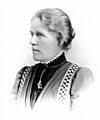Margaret Jane Benson facts for kids
Quick facts for kids
Margaret Jane Benson
|
|
|---|---|

c. 1911
|
|
| Born | 20 October 1859 |
| Died | 20 June 1936 (aged 76) |
| Nationality | British |
| Scientific career | |
| Fields | Botany |
Margaret Jane Benson (born October 20, 1859 – died June 20, 1936) was a British scientist who studied plants. She was especially interested in paleobotany, which is the study of ancient plants from fossils. Margaret Benson was also one of the first women to become a member of the Linnean Society of London, a very old and respected science group.
For most of her career, she was the head of the Botany Department at Royal Holloway College, which is part of the University of London. She held this important role from 1893 until she retired in 1922. In 1927, a special laboratory for studying plants was named in her honor. Margaret Benson loved to travel. She explored many places with her friend Ethel Sargant. Together, they collected plant samples, found equipment for their lab, and met other plant scientists from all over the world. Some of her students, like Helen Gwynne-Vaughan, also became very successful scientists.
Contents
Her Early Life and Studies
Margaret Benson was born in London on October 20, 1859. Her parents were William Benson and Edmunda Bourne. Her mother was an artist who even showed her paintings at the Royal Academy of Art.
Margaret's father, who was an engineer and architect, first introduced her to the world of plants. She was initially taught by her sister, who had attended Queens College. In 1878, Margaret studied Classical Studies at Newnham College, Cambridge, for one year. After that, she worked as a teacher at Exeter High School for seven years. This job helped her save enough money to go to university.
In 1887, she started studying at University College London. She earned her bachelor's degree in Botany in 1891 with top honors. She then received a special scholarship for research. In 1894, she earned her doctorate degree from the University of London. She worked with a scientist named Francis Wall Oliver. Her research focused on how certain types of plants, called Fagales, developed.
Amazing Work and Discoveries
Margaret Benson began working as a lecturer at Royal Holloway College in 1889. By 1893, she was made the head of the Botany Department there. She was the very first woman to lead a botany department in the United Kingdom! She stayed in this role until she retired in 1922.
In 1897, Benson traveled across Europe with Ethel Sargant. They went to gather equipment and knowledge to help set up their department. Margaret Benson is also known for planning and filling the college's Botanical Garden, Herbarium (a collection of dried plants), and Museum.
Margaret Benson went on many trips to collect plant materials. She visited Australia in 1905–1906, and then Australia, Java, and India in 1914–1915. Her observations of early plants from the Paleozoic era and the first true ferns are very important. She also suggested a way that plant ovules (which develop into seeds) might have evolved. This idea is still considered a likely explanation today.
She also described a plant species called Cordaites felicis. This plant was found in coal deposits in England. To study fossils in a new way, she used a gas-powered machine in her garden shed to cut very thin slices of them. Her scientific papers are known for their very detailed drawings and paintings, which she is believed to have created herself.
In 1904, Margaret Benson became a fellow of the Linnean Society of London. She was one of the first fifteen women ever allowed to join this prestigious group. In 1912, the University of London made her a Professor.
Her Legacy
When Margaret Benson retired in 1922, Professor Elizabeth Marianne Blackwell took over as the Head of Botany at Royal Holloway College. Margaret Benson passed away on June 20, 1936. Professor Blackwell later wrote her official obituary, which is a notice of someone's death.
Images for kids
See also
 In Spanish: Margaret Jane Benson para niños
In Spanish: Margaret Jane Benson para niños


